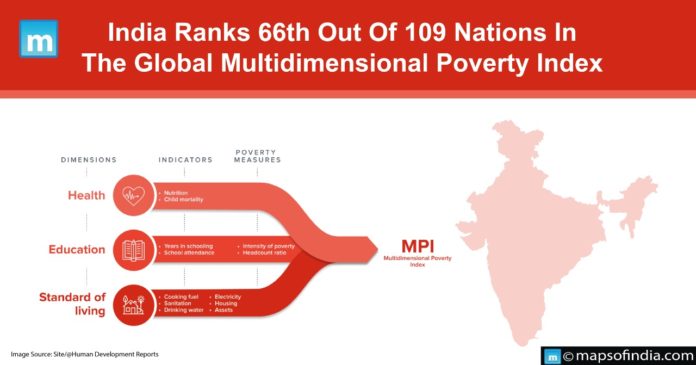The Multidimensional Poverty Index (MPI) strives to quantify poverty across its various facets and, in doing so, supplements current data on poverty based on per capita consumer expenditure. Regarding the Global Multidimensional Poverty Index 2021, India secured 66th rank out of 109 nations. The National MPI aims to disassemble the Global MPI and build a tailored and comprehensive Policy Action Plan to improve India’s status in the Global MPI rankings. The India MPI has been internationally integrated.
It has three equal aspects: standard of living, health, and education. Twelve indicators, including food intake, school involvement, years of schooling, drinking water, cleanliness, housing, and bank accounts, reflect these three aspects.
Research & Data
The Oxford Poverty and Human Development Initiative (OPHI) and the UNDP created a reliable methodology used by the national MPI measure.
Using the National Family Health Survey’s time frame of 2015–16, this baseline report is for the national MPI measure. Before implementing several central government programmes, a notion of baseline multidimensional poverty was derived using NFHS-4 data to understand the reality on the ground.
Before implementing the central government’s flagship programmes for housing, clean water, power, cooking fuel, financial inclusion, and other significant initiatives to improve school attendance, nourishment, mother and child health, etc., NFHS-4 is implemented.
The NFHS-5 data does, however, indicate improved access to clean cooking fuel, sanitary facilities, and power, equating to decreased deprivation.
Observations of the Index
- Bihar has the most significant percentage of its population living in poverty on a multidimensional scale, followed by the state of Jharkhand and Uttar Pradesh.
- The state with the lowest poverty rates was Kerala, which Puducherry, Lakshadweep, and Sikkim followed.
- Underweight people are most prevalent in Bihar, followed by Jharkhand, Uttar Pradesh, and Chhattisgarh.
Relevance of the Index
- Contribution to the implementation of Public Policy Instrument
The Index is a significant step toward establishing a public policy instrument that tracks multidimensional poverty and guides evidence-based actions. It ensures that no one is left behind.
- Describes the Global Situation of Poverty
This supplements the current monetary poverty data by providing an overall picture of poverty in the nation while permitting closer and more in-depth analysis of particular focus areas such as regions, states, or districts.
- Help achieve Sustainable Development goals
Goal 1.2 of the Sustainable Development Goals (SDGs) is to reduce “at least by half the proportion of men, women, and kids of all ages living in poverty in all its aspects,” This measure helps track progress towards that goal.
The Global Multidimensional Poverty Index: What Is It?
The index is a crucial global tool for measuring severe, multifaceted poverty in more than 100 developing nations.
The OPHI and the UNDP’s Human Development Report Office introduced it in 2010. The MPI tracks the prevalence and the degree of poverty in ten variables, including health, education, and standard of life.
Global MPI Determinants and Dimensions
If a person is deficient in at least one-third (i.e., at least 33% of the weighted indicators), they are considered multidimensionally poor. Extreme multidimensional poverty is defined as the presence of one-half or more of the weighted indicators.




